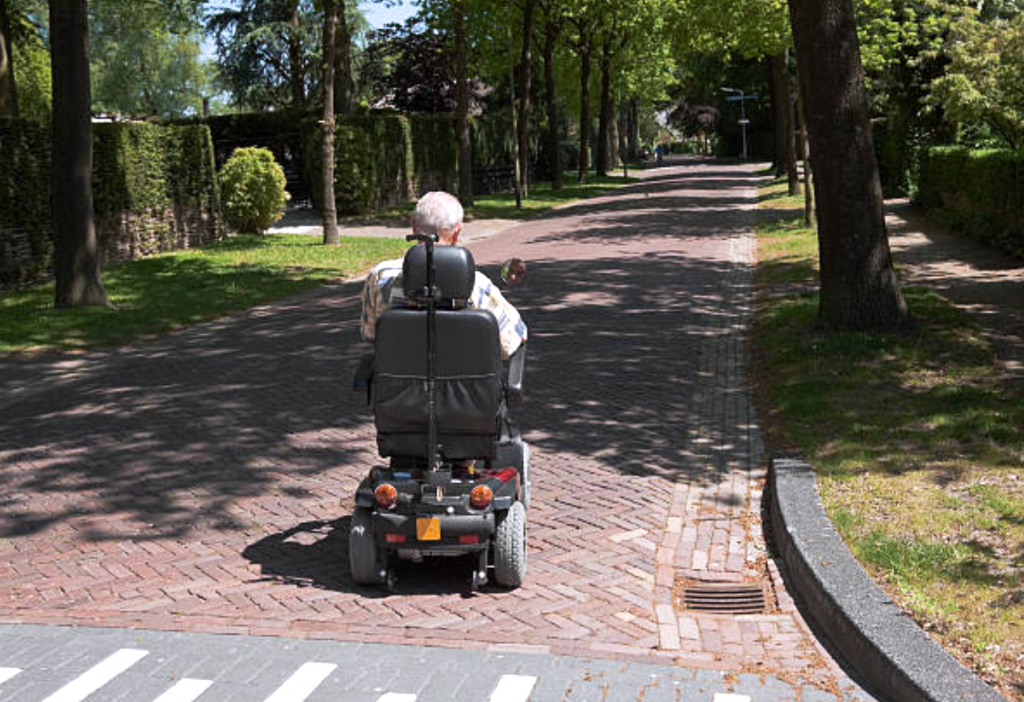




Because storage baskets can be readily fitted to the front area of mobility scooters, they are great for shopping and errands. This makes them more convenient to use and transfer. Unlike power wheelchairs, they may be disassembled and transported in the trunk of a car. Purchasing a Mobility Scooter can be overwhelming with how many products are on the Market. There are 5 considerations when purchasing a Mobility Scooter.
Some scooters are designed for recreational use while others are intended to assist users with limited mobility. Mobility scooters are available with 3 or 4-wheels in heavy-duty or lightweight designs.
It is important to determine if the mobility scooter will primarily be used indoors or outdoors to select the best model for your needs.
The scooter’s turning radius is the amount of space required to complete a full 360° turn. Compact 3-wheel scooters navigate narrow hallways and corners with their small wheels with a tight turn radius. Non-marking tires protect indoor floors while anti-tip wheels protect the user.
Durable, flat-free wheels are best for navigating various types of outdoor terrains. Large, wide wheels more easily over rough terrain, allowing a smoother ride for the user. The high ground clearance allows the chair to navigate obstacles without bottoming out. Maximum range is an important consideration so that the user can travel desired distances without having to recharge the battery.
The user should be able to reach the steering control without having to arch the back. The knees should be bent at a 90-degree angle and the feet resting flat on the footrest. The listed weight capacity must accommodate the user as well as other items that will be carried on the scooter.
A contoured captain’s seat is designed for comfort and support, making it suitable for long periods of use. Compact scooters typically have narrower lightweight seats with folding backrests.
The tiller controls the direction and speed of the mobility scooter.
A standard handlebar-type tiller requires the user to hold it with both hands. Constant pressure and manual dexterity are needed to control speed and turn signals. Delta tillers have an oval shape that can be controlled with either hand. Less dexterity is required as the speed is controlled with a center dial.
The Drive Medical Spitfire DST features a delta tiller with the central-mount speed control dial.
Some scooters may fold or be dismantled so that they can be transported without the need for ramps, hoists, or trailers. They are ideal for traveling by plane, train, or automobile.
Folding scooters fit in the trunk of a car without the need for a hoist, ramp, or trailer. Portable scooters come with electronic or manual-folding.
Portable scooters may be taken apart so that lightweight components are easily lifted into the trunk of a car.
Now that you purchased your Mobility Scooter, it is important to maintain it. All power scooters require regular care to ensure that they continue to function correctly. Power scooters should be kept in a clean, dry place at room temperature. Recharge batteries after every use. Keep the battery fully charged and never drained completely. Exposure to extreme temperatures can damage electronics and plastics. Do not expose batteries and electronics to water or moisture. Wipe The controller, seat, and frame clean as often with a damp cloth and mild cleaner.
Daily checks:
Weekly checks:
Monthly checks:
Overall, with this article, I hope you can get to answer most of the questions you have about mobility scooters. Whether indoors or outdoors, power scooters allow you or your loved ones to get around easily. At HomeCare Hospital Beds we want to help you make an informed decision. If you have any doubts about which power scooter is best for you, please contact our HomeCare Hospital Beds team to help you make the right choice. Call us today toll-free at 877-414-0002 or email us at info@homecarehospitalbeds.com.




| Cookie | Duration | Description |
|---|---|---|
| cookielawinfo-checkbox-analytics | 11 months | This cookie is set by GDPR Cookie Consent plugin. The cookie is used to store the user consent for the cookies in the category "Analytics". |
| cookielawinfo-checkbox-functional | 11 months | The cookie is set by GDPR cookie consent to record the user consent for the cookies in the category "Functional". |
| cookielawinfo-checkbox-necessary | 11 months | This cookie is set by GDPR Cookie Consent plugin. The cookies is used to store the user consent for the cookies in the category "Necessary". |
| cookielawinfo-checkbox-others | 11 months | This cookie is set by GDPR Cookie Consent plugin. The cookie is used to store the user consent for the cookies in the category "Other. |
| cookielawinfo-checkbox-performance | 11 months | This cookie is set by GDPR Cookie Consent plugin. The cookie is used to store the user consent for the cookies in the category "Performance". |
| viewed_cookie_policy | 11 months | The cookie is set by the GDPR Cookie Consent plugin and is used to store whether or not user has consented to the use of cookies. It does not store any personal data. |